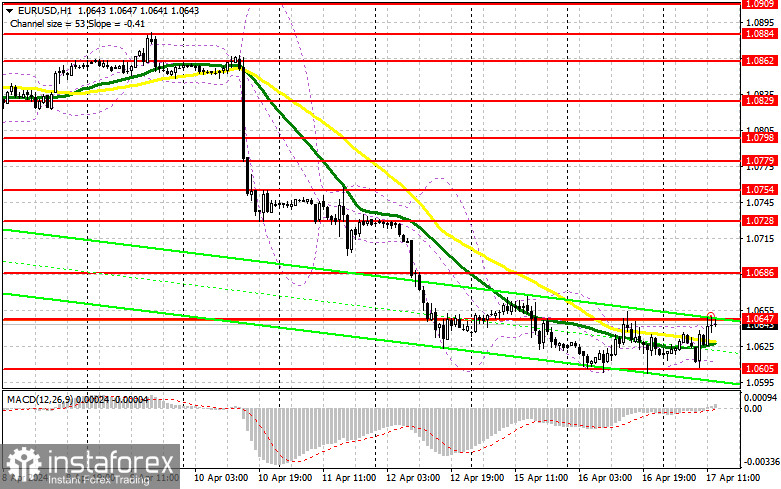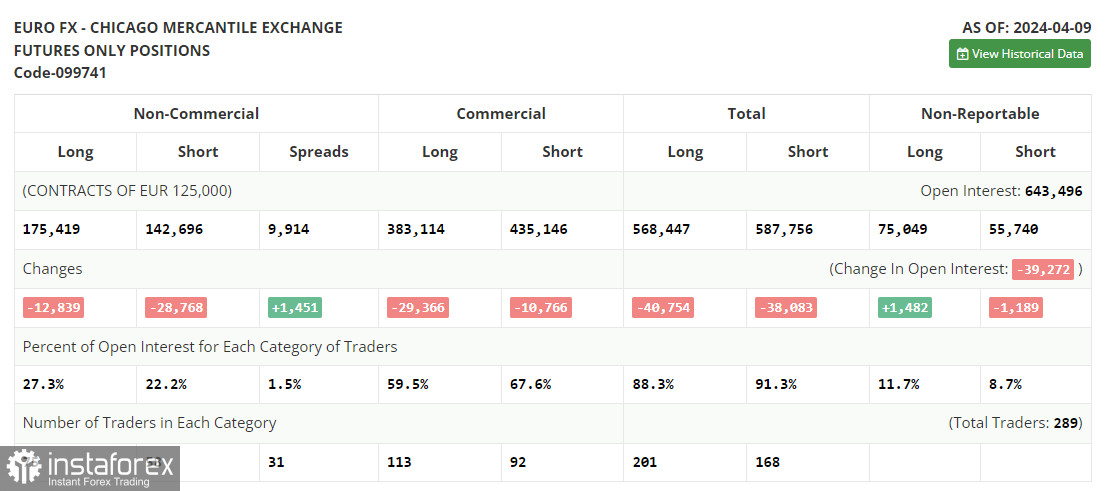In my morning forecast, I paid attention to the level of 1.0647 and planned to make trading decisions based on it. Let's look at the 5-minute chart and analyze what happened there. Growth and the formation of a false breakout around 1.0647 led to a sell signal, which was not fully realized. After a downward movement of 10 points, the pair returned to 1.0647, where trading occurs. For this reason, I exited short positions and reviewed the technical picture.

For opening long positions on EUR/USD, the following is required:
The inflation data in the eurozone for March of this year was not revised and fully coincided with economists' forecasts, allowing the European currency to somewhat recover its positions in anticipation of updating yesterday's high, which we have yet to reach. Obviously, in the absence of important statistics from the US, apart from speeches by Federal Reserve representatives, there is nothing else on our calendar; euro buyers will likely continue their attempts to push the pair higher. But remember yesterday's scenario, where an unsuccessful consolidation near the daily high led to a significant sell-off. Nevertheless, the trend remains downward. For this reason, I prefer to act only on declines after forming a false breakout around the new support level of 1.0605, formed based on yesterday's results. This will be a suitable option for buying in anticipation of another correction towards 1.0647. A breakout and update from top to bottom of this range will strengthen the pair with a chance of a surge to 1.0686. The ultimate target will be the high of 1.0728, where I will take profit. In the case of further decline of EUR/USD and lack of activity around 1.0605 in the second half of the day, pressure on the euro within the bearish market will only intensify. In this case, I will enter the market only after forming a false breakout around the next support at 1.0569. I plan to open long positions immediately on the rebound from 1.0545 with the target of an upward correction of 30-35 points within the day.
For opening short positions on EUR/USD, the following is required:
Euro sellers have every chance of further decline. The formation of a false breakout around the new resistance of 1.0647, which has already helped sellers several times over the past couple of days, will be, albeit not perfect, but a scenario for entering short positions with the prospect of updating support at 1.0605. A breakout and consolidation below this range and a reverse test from bottom to top will provide another selling point, with the pair moving towards 1.0569, reinforcing the bearish trend. There, I expect more active participation from major buyers. The ultimate target will be the low of 1.0545, where I will take profit. In case of upward movement of EUR/USD in the second half of the day and the absence of bears at 1.0647, which is more likely, bulls will try to continue the correction. In this case, I will postpone sales until testing the next resistance at 1.0686. I will also sell there, but only after an unsuccessful consolidation. I plan to open short positions immediately on the rebound from 1.0728 with the target of a downward correction of 30-35 points.


Indicator signals:
Moving averages:
Trading is slightly above the 30 and 50-day moving averages, indicating attempts to push the euro higher.
Note: The author considers the period and prices of moving averages on the hourly chart H1, which differs from the general definition of classic daily moving averages on the daily chart D1.
Bollinger Bands:
In case of decline, the lower boundary of the indicator at around 1.0605 will act as support.
Description of indicators:
- Moving average (determines the current trend by smoothing volatility and noise). Period 50. Marked on the chart in yellow.
- Moving average (determines the current trend by smoothing volatility and noise). Period 30. Marked on the chart in green.
- MACD indicator (Moving Average Convergence/Divergence - convergence/divergence of moving averages) Fast EMA period 12. Slow EMA period 26. SMA period 9.
- Bollinger Bands. Period 20.
- Non-commercial traders - speculators, such as individual traders, hedge funds, and large institutions using the futures market for speculative purposes and meeting certain requirements.
- Long non-commercial positions represent the total long open position of non-commercial traders.
- Short non-commercial positions represent the total short open positions of non-commercial traders.
- The total non-commercial net position is the difference between non-commercial traders' short and long positions.
 English
English 
 Русский
Русский Bahasa Indonesia
Bahasa Indonesia Bahasa Malay
Bahasa Malay ไทย
ไทย Español
Español Deutsch
Deutsch Български
Български Français
Français Tiếng Việt
Tiếng Việt 中文
中文 বাংলা
বাংলা हिन्दी
हिन्दी Čeština
Čeština Українська
Українська Română
Română

